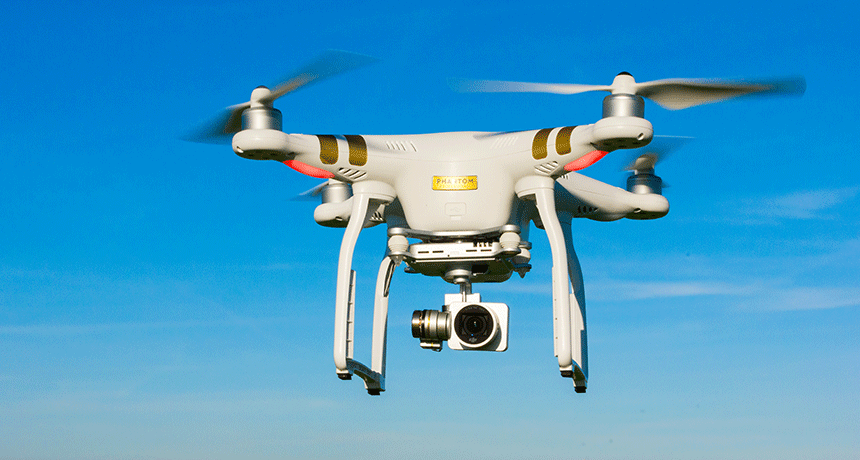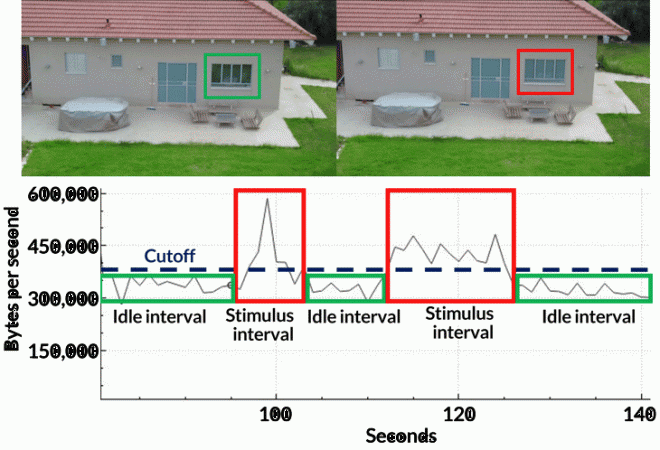How to tell if a drone is stalking you
Researchers can now detect when a flying robot is streaming video of you or your home

A new technique can show when a sneaky robot is streaming video of you or your home.
NatureNow/istockphoto
Now there’s a way to tell if you’re being spied on by eyes from the sky.
Researchers have developed a method to find out what a drone — a flying robot — is recording. And they can tell without having to translate the video information that the device is streaming to its pilot. This technique, described January 9 on the site arXiv.org, could help military bases detect unwanted robotic snoops. It also could help civilians protect their privacy as more drones take to the air.
“People have already worked on detecting [the presence of] drones,” says Ahmad Javaid. He studies cybersecurity — or how to keep computers secure from spies — at the University of Toledo in Ohio. “But no one had solved the problem of, ‘Is the drone actually recording something in my direction?’”
Ben Nassi is a software engineer. That’s someone who develops computer programs. He works in Israel at Ben-Gurion University of the Negev. The images streaming from a drone are made up of tiny lighted areas, called pixels. Nassi’s group realized it could change how objects look to a drone. When something it’s recording changes (say, switches to a different color), the stream of encrypted data that the drone broadcasts to a computer (that controls it) also will change. (Encrypted data are those that have been put into a secret code.)
The drone sends those data via Wi-Fi. When the pixels change color, the data need to change, too. The more pixels that change from one video frame to the next, the more data the drone sends per second. So if a scientist could rapidly switch the appearance of a person or house, the drone’s pixel information would switch as well. That would require more data. And the scientists could then track whether the appearance changes corresponded to higher drone-to-phone Wi-Fi traffic. If they do, that suggests the drone might be recording you.
Spotting drone signals
Nassi’s team decided to test this idea. They covered a house window with a special film. It could switch between clear and nearly solid white. To do that, they merely had to point a remote control at it. The researchers either flickered this “smart” film back and forth every two seconds or left it clear. Then the scientists aimed a drone with a video camera at the window from 40 meters (130 feet) away and hit “record.”
The flickers should show up on the drone’s video as pixel changes. To find out if it did, the scientists pointed a scanner at the drone that could detect radio waves. Those were the Wi-Fi signals being broadcast by the drone. And sure enough, the drone’s Wi-Fi traffic spiked whenever the smart film flickered. That confirms that a simple radio scanner can tell when a drone is videotaping a window.
Story continues below image.

Using radio equipment may not be strictly required. It’s possible to intercept Wi-Fi signals with a laptop or other computer with a wireless card, says Simon Birnbach. He’s a computer scientist not involved in the work. He works in England at the University of Oxford.
In a second test, a drone recorded someone from about 20 meters (66 feet) away. This person was wearing a strand of LED lights. (These are also known as light-emitting diodes.) Every five seconds, the lights flickered on and off, or just stayed off. Data streaming from the drone’s camera spiked whenever the lights flickered. These data show that scanning data from the drone could detect surveillance of even an individual.
This technique to identify a drone camera’s target is “a very cool idea,” says Thomas Ristenpart. He’s a computer scientist not involved in the new study. He works at Cornell University in Ithaca, N.Y. Still, he says, the researchers need to test whether this technique will work for more than a house window or flashing lights. “I don’t think anyone is going to want to wear a [light-up] shirt on the off chance a drone may fly by,” he quips.
Javaid agrees. This prototype system must be more user-friendly, he says. For home security, he imagines a small device with a flashing light stuck to a window. It could intercept a passing drone’s Wi-Fi signals. That could alert the homeowner when a snooping drone flew by.
Drew Davidson works as a computer scientist at Tala Security, Inc. in Dallas, Texas. He was not involved in the new work. He points out that even if you knew a drone was nosing around, you may not know who was controlling it. “It’s sort of the equivalent of knowing that an unmarked van pulled up and waited outside of your house,” he says. “[It’s] better to know than not,” he says. Still, he adds, it may not be enough for the police to track down the snoop.







